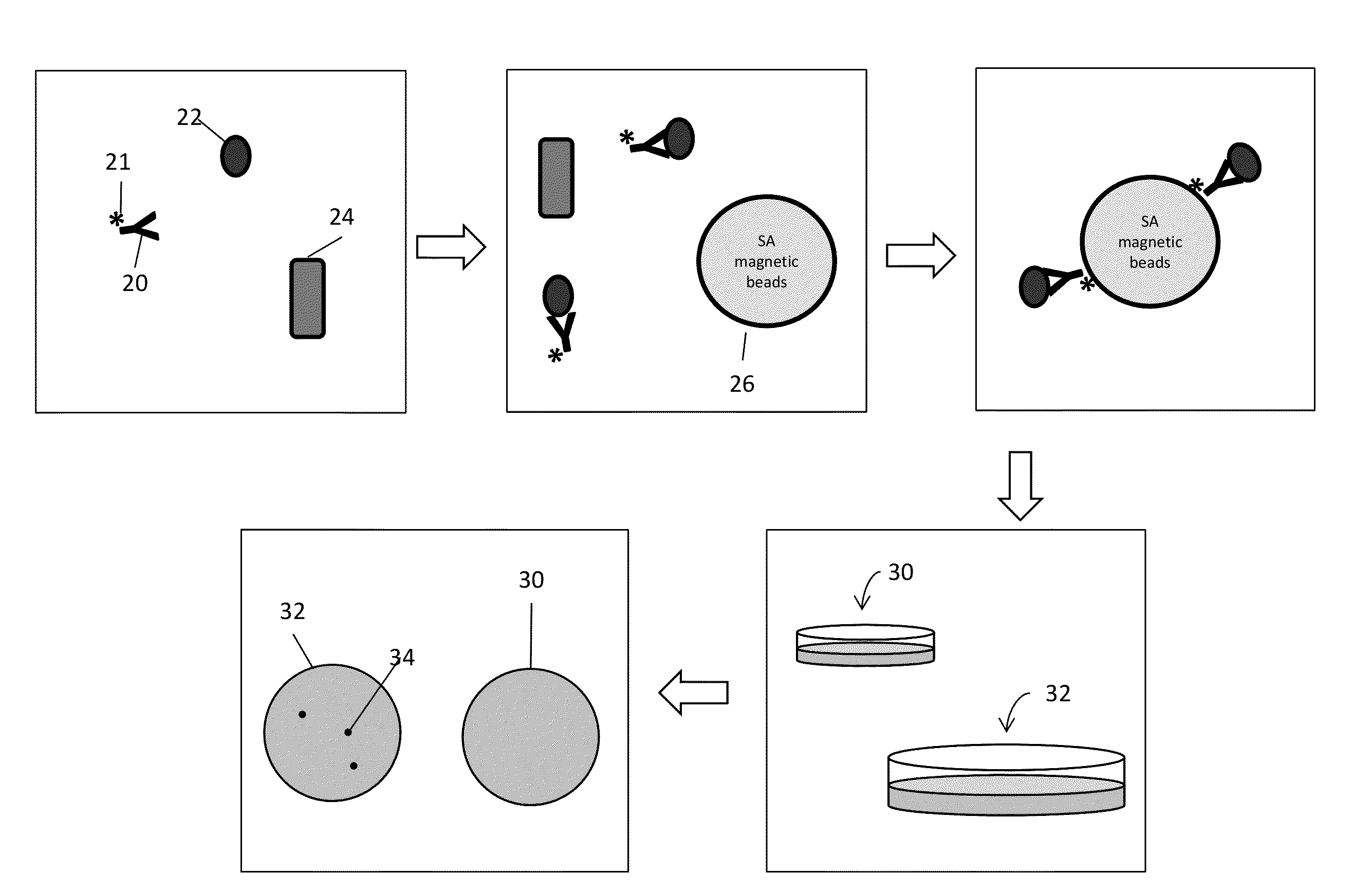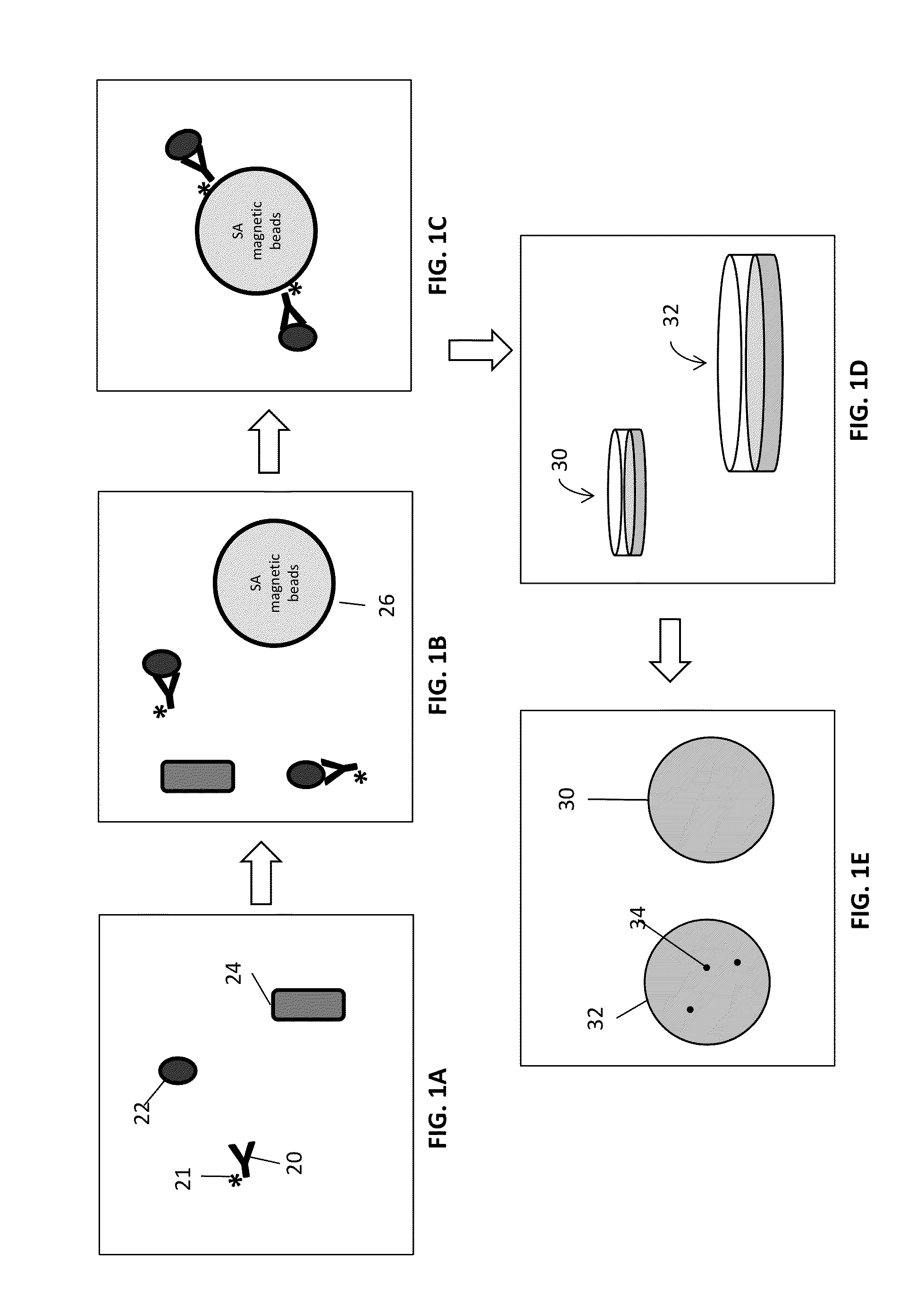Methods and Systems for Detection of Microorganisms
a microorganism and detection method technology, applied in the field of methods and systems for the detection of microorganisms, can solve the problems of requiring several days of procedures, affecting the detection efficiency of microorganisms, so as to facilitate the detection of ribosomes
- Summary
- Abstract
- Description
- Claims
- Application Information
AI Technical Summary
Benefits of technology
Problems solved by technology
Method used
Image
Examples
example 1
Purified Ribosome Isolation
[0195]E. coli was obtained from ATCC (#11303) and cultured in LB Medium (Difco: 10 g Tryptone, 5 g yeast extract, 10 g NaCl / L) overnight at 37° C. A colony was placed in 5 mL of LB Medium and incubated at 37° C. overnight. The following day the culture was diluted 1:100 in fresh LB and the cells grown to a concentration of Klett 68 (OD at 600 nm=0.8) (20 Klett units on a Summerson Photoelectric Colorimeter=0.1 OD at 540 nm on a spectrophotometer), which corresponds to approximately 4×108 cells / mL after growth for about 3.5 hours. The cells were then pelleted in a Beckman Coulter XL 80K Type 19 rotor (Cat. No. 325632) at 5,000 rpm for 15 minutes. The pellet was resuspended in 1 mL TMS (50 mM Tris-HCl, pH 7.8, 10 mM MgCl2, 100 mM NaCl) with 1 / 10 volume of 10× Bugbuster (Novagen, PN 70921-3), 0.5 mg / ml lysozyme (Sigma L6876), and 10 μg / mL high quality DNaseI (RNase free) (USB 14365). The lysate was clarified in a 1.5 mL microfuge tube in a Beckman Coulter All...
example 2
Polyclonal Antibody Production in Rabbits
[0196]Purified ribosomes, isolated as described in Example 1, were combined with an appropriate adjuvant. The ribosomes and adjuvant were injected beneath the skin of young rabbits (2.5-3.0 kg; 10-16 weeks of age). Blood was collected from the central ear artery with a 19-gauge needle and allowed to clot and retract at 37° C. overnight. The clotted blood was then refrigerated for 24 hours before the serum was decanted and clarified by centrifugation at 2500 rpm for 20 minutes. The rabbits were injected and bled according to the following schedule:
Day −4: Pre Bleed
[0197]Day 0: Immunize via an intradermal (ID) route using CFA (Complete Freund's Adjuvant)
Day 7: Booster injection via an intradermal (ID) route using IFA (Incomplete Freund's Adjuvant)
Day 14: Booster injection via a subcutaneous (SC) route using IFA
Day 28: Booster injection via a subcutaneous (SC) route using IFA
Day 38: Test Bleed
[0198]Day 40: Ship pre-immune bleeds and test bleeds ...
example 3
Bacteria Capture from Solution Using Cell-Specific Antibodies and Magnetic Microparticles
[0199]In order to demonstrate capturing intact, viable bacterial cells from solution rabbit polyclonal antibodies to surface epitopes of various bacterial species (e.g., E. coli and S. typhimurium) were generated.
[0200]Cultures of both E. coli and S. typhimurium were grown in liquid media before harvesting and were washed with phosphate buffer (1.1 mM KH2PO4, 5.6 mM Na2HPO4, 154 mM NaCl, pH 7.4). The washed cells were then diluted to a concentration between 5-20 cells per ml. Approximately 250 ng biotinylated, polyclonal anti-E. coli antibody (equivalent to about 1×1012 antibody molecules) produced by Rockland Immunochemicals Inc., Gilbertsville, Pa. was added to the cell suspension and allowed to incubate for 45 min. A control experiment, where antibody is not added to the cell suspension, was also done.
[0201]Following antibody incubation, 4×108 streptavidin-coated magnetic microparticles (Solu...
PUM
| Property | Measurement | Unit |
|---|---|---|
| time | aaaaa | aaaaa |
| diameter | aaaaa | aaaaa |
| diameter | aaaaa | aaaaa |
Abstract
Description
Claims
Application Information
 Login to View More
Login to View More - R&D
- Intellectual Property
- Life Sciences
- Materials
- Tech Scout
- Unparalleled Data Quality
- Higher Quality Content
- 60% Fewer Hallucinations
Browse by: Latest US Patents, China's latest patents, Technical Efficacy Thesaurus, Application Domain, Technology Topic, Popular Technical Reports.
© 2025 PatSnap. All rights reserved.Legal|Privacy policy|Modern Slavery Act Transparency Statement|Sitemap|About US| Contact US: help@patsnap.com



